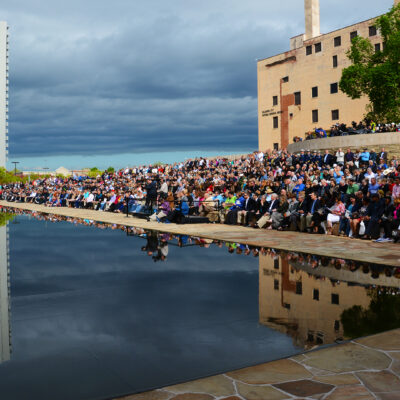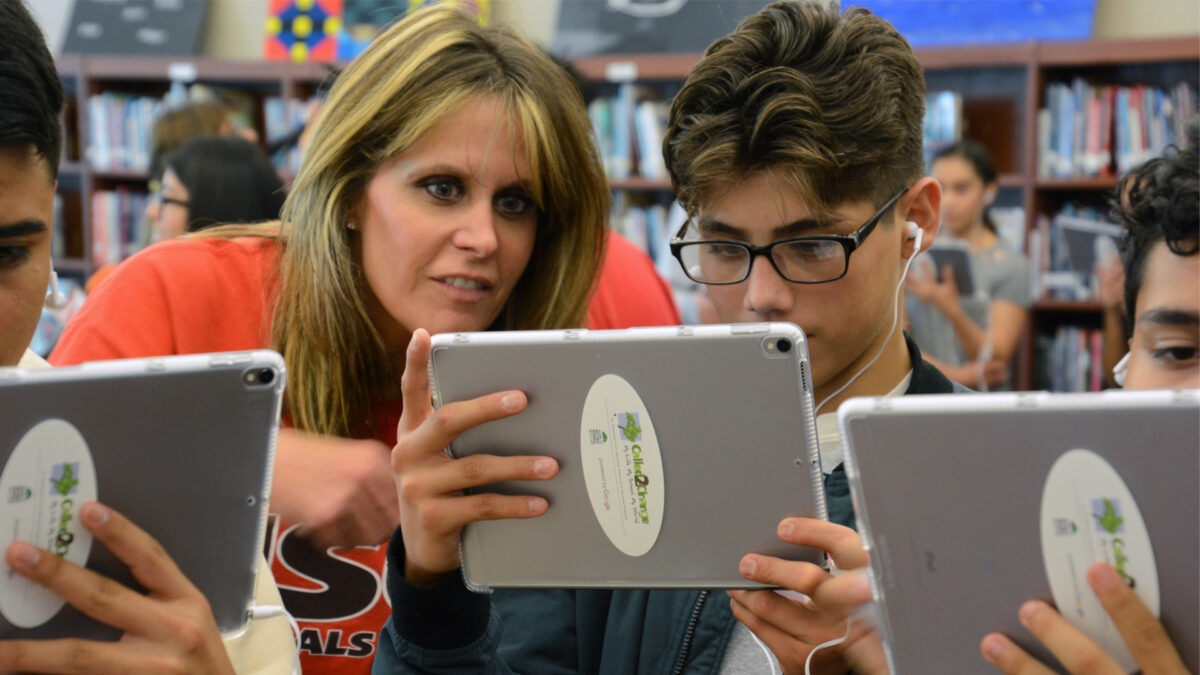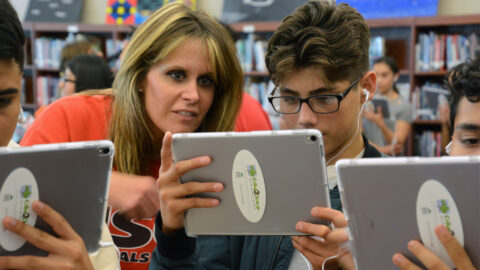Lesson Plan
What Is the Role of a Journalist?
The role of a journalist during a tragedy is a unique one. We read heart touching stories, view heart-breaking images and listen to miraculous survivor stories, yet we never think about the people that work tirelessly to bring these stories to the public – the journalists.
In today’s world, it seems like positive stories are rare. The messages journalists write for the public are important in telling the details that history books leave behind. Headlines from pictures of the Oklahoma City bombing were historic and powerful; however, instead of focusing on the hate that birthed this horrific act of terror, many journalists focused on and wrote about the hope and honor that came from such a wicked act. Journalists helped promote the Oklahoma Standard by spreading positive images about Oklahomans’ reactions to this devastating event.
Lesson Summary
Students will analyze and examine the role of journalists during the Murrah Building bombing.
- Essential Questions: What is the role of a journalist? How can you inspire a movement of love from an event created by hatred?
- Time frame: 2-3 class periods
- Subject(s): Social Studies, English
Materials Needed
- Pencil
- Notebook Paper
- Colored Pencils
- Markers
- Journalism RAFT
- Poster Paper (used with Color, Symbol, Image)
- Blank Frayer Model
- Frayer Model OKC example (Teachers use this as the model for Frayer Model)
Teacher Tip: Make more than one copy of anything you model so kids can pass it around and get a closer look. This allows visual and kinesthetic students to pay more attention to the model.
Lesson
Students will look at several images from the Murrah Building bombing and create their own headlines.
- Create the headline: Give students 5-6 images from the Oklahoma City bombing.
- Individually, or in pairs, students will create their own headlines from viewing the images.
- Allow students to share their headlines with the class.
Students will create their own definition of journalism using the Frayer Model.
- Invite students to create their own definitions of journalism. Students will then separate a page into four quadrants by drawing one horizontal line and one vertical line (essentially drawing a full-page plus sign) with an oval in the center.
- They label quadrants as follows (beginning from the upper-left quadrant moving clockwise): definition, characteristics, examples, non-examples.
- Students will then write journalism in the center oval of the graphic organizer.
- Students may use their own definition of journalism or add new information to their definition after they have researched the topic.
Teacher Tip: Be sure students do not copy the definition from the websites. If your students are struggling you can model how to complete the Frayer Model with a more familiar concept such as the Oklahoma City Thunder. - Once the model is complete, let the students share their ideas with a partner or group, modifying their diagrams as they accept new information.
Students will analyze the role of the journalists, telling stories after watching a video of people who were impacted by the bombing.
- Students will watch a video featuring stories from people impacted by the bombing.
- Individually, students will then write a two-minute paper explaining why these individual stories are important enough to tell the world.
- Individually, students will create a list of their own interview questions. Four to five questions should be a good amount.
- Students will then get together in pairs and hold mock interviews with each other. Each story should be based on an individual impacted by the Murrah Building bombing.
Students will analyze newspaper articles using the Color, Symbol and Image (CSI) strategy.
- Color, Symbol and Image: Students will use the stories from individuals impacted by the bombing, articles and images from the Murrah Building bombing to create a poster.
- Students should write what they already know about this event.
- Independently or in small groups, students then select a color, create a symbol, and draw an image that represents the impacted individual’s story and articles, then have them justify their choices.
- Once their colors, symbols, and images are complete, students can share their CSI boards with the rest of the class.
Students will create their own articles using the Role, Audience, Format, and Topic (RAFT) strategy.
- After analyzing the stories of survivors and researching various articles, students will use the RAFT strategy.
- The teacher should hand out the RAFT to students.
- Describe each of the RAFT categories using simple examples.
- Teachers should model how to write responses to the prompts and discuss the key elements as a class.
- Students then choose a row of the RAFT to use as a prompt.
- Students write their assignment based on the prompt they selected.
- It is optional to have a few students read their RAFTs aloud. Another way of discussion is to have a whole-class discussion about all of the RAFTs that were read out loud – even if they used the same role, audience, format and topic.
Journalism Raft
Directions: Students will choose one of the roles below. The written assignment should be one page in length. Be sure to pay attention to who your audience is, what format your writing assignment will be and the topic you will be writing over.
okcm-c2c-lesson-plan-journalism-raftOklahoma History 5.10 Cite specific textual and visual evidence to analyze the causes and effects of the domestic terrorist attack on the Murrah Federal Building in Oklahoma City including the responses of Oklahomans to the event, the concept of the Oklahoma Standard and the creation of the Oklahoma City National Memorial & Museum.
English Standard 12.8.W Students will write independently over extended periods of time (e.g., time for research, reflection, and revision) and for shorter timeframes (e.g., a single sitting or a day or two), vary their modes of expression to suit audience and task, synthesize information across multiple sources, and articulate new perspectives.
NCSS Standards D2.Civ.2.K-2. Explain how all people, not just official leaders, play important roles in a community.
Color, Symbol, Image (CSI) – Keeley, P. (2015). Science formative assessment: 50 more strategies for
Frayer Model – Keeley, P. (2008). Science formative assessment: 75 practical strategies for linking assessment, instruction, and learning. Thousand Oaks, CA: Corwin, SAGE.
RAFT – West Virginia Department of Education. (n.d.) RAFT. Retrieved from https://wvde.state.wv.us/strategybank/RAFT.html





